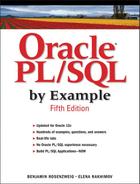Book Description
Using PL/SQL for Oracle Database 12c, you can build solutions that deliver unprecedented performance and efficiency in any environment, including the cloud. Oracle® PL/SQL by Example, Fifth Edition, teaches all the PL/SQL skills you’ll need, through real-world labs, extensive examples, exercises, and projects. Now fully updated for the newest version of PL/SQL, it covers everything from basic syntax and program control through the latest optimization and security enhancements.
Step by step, you’ll walk through every key task, mastering today’s most valuable Oracle 12cPL/SQL programming techniques on your own. Start by downloading projects and exercises from informit.com/title/0133796787. Once you’ve done an exercise, the authors don’t just present the answer: They offer an in-depth discussion introducing deeper insights and modern best practices.
This book’s approach fully reflects the authors’ award-winning experience teaching PL/SQL to professionals at Columbia University. New database developers and DBAs can use it to get productive fast; experienced PL/SQL programmers will find it to be a superb Oracle Database 12csolutions reference.
New in This Edition
Updated code examples throughout
Result-caching of invoker’s right functions for better performance
Extended support for PL/SQL-only data types in dynamic SQL, OCI, and JDBC
Security enhancements, including ACCESSIBLE BY whitelists, improved privilege control, and Invisible Columns
Other topics covered
Mastering basic PL/SQL concepts and language fundamentals, and understanding SQL’s role in PL/SQL
Using conditional and iterative program control, including CONTINUE and CONTINUE WHEN
Efficiently handling errors and exceptions
Working with cursors and triggers, including compound triggers
Using stored procedures, functions, and packages to write modular code that other programs can run
Working with collections, object-relational features, native dynamic SQL, bulk SQL, and other advanced features
Table of Contents
- About This eBook
- Title Page
- Copyright Page
- Dedication Page
- Contents
- Preface
- Acknowledgments
- About the Authors
- Introduction to PL/SQL New Features in Oracle 12c
- Invoker’s Rights Functions Can Be Result-Cached
- More PL/SQL-Only Data Types Can Cross the PL/SQL-to-SQL Interface Clause
- ACCESSIBLE BY Clause
- FETCH FIRST Clause
- Roles Can Be Granted to PL/SQL Packages and Stand-Alone Subprograms
- More Data Types Have the Same Maximum Size in SQL and PL/SQL
- Database Triggers on Pluggable Databases
- LIBRARY Can Be Defined as a DIRECTORY Object and with a CREDENTIAL Clause
- Implicit Statement Results
- BEQUEATH CURRENT_USER Views
- INHERIT PRIVILEGES and INHERIT ANY PRIVILEGES Privileges
- Invisible Columns
- Objects, Not Types, Are Editioned or Noneditioned
- PL/SQL Functions That Run Faster in SQL
- Predefined Inquiry Directives $$PLSQL_UNIT_OWNER and $$PLSQL_UNIT_TYPE
- Compilation Parameter PLSQL_DEBUG Is Deprecated
- 1. PL/SQL Concepts
- 2. PL/SQL Language Fundamentals
- 3. SQL in PL/SQL
- 4. Conditional Control: IF Statements
- 5. Conditional Control: CASE Statements
- 6. Iterative Control: Part I
- 7. Iterative Control: Part II
- 8. Error Handling and Built-in Exceptions
- 9. Exceptions
- 10. Exceptions: Advanced Concepts
- 11. Introduction to Cursors
- 12. Advanced Cursors
- 13. Triggers
- 14. Mutating Tables and Compound Triggers
- 15. Collections
- 16. Records
- 17. Native Dynamic SQL
- 18. Bulk SQL
- 19. Procedures
- 20. Functions
- 21. Packages
- 22. Stored Code
- 23. Object Types in Oracle
- 24. Oracle-Supplied Packages
- 25. Optimizing PL/SQL
- A. PL/SQL Formatting Guide
- B. Student Database Schema
- Index
- Code Snippets
